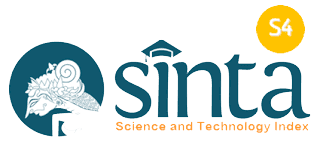The Influence of Return on Equity Ratio and Debt to Equity Ratio to Price to Earning Ratio in Galvalum Companies Listed on the Indonesia Stock Exchange for the 2014-2018 Period
(1) Universita Pamulang
(*) Corresponding Author
DOI: https://doi.org/10.26858/pdr.v3i2.13370
Abstract
The development of the capital market in Indonesia has encouraged companies to sell their shares to the public so that more companies are listed on the Indonesian stock exchange. This study aims to determine the effect of Return On Equity Ratio and Debt to Equity Ratio on Price to Earning Ratio in Galvalum Companies listed on the Indonesia Stock Exchange Period 2014-2018. The method used is explanatory research with a sample of 5 years of financial statements. The analysis technique uses statistical analysis with regression testing, correlation, determination, and hypothesis testing. The results of this study Return On Equity Ratio significantly influence the Price to Earning Ratio of 47.8%, the hypothesis test obtained significance of 0,000 <0.05. Debt to Equity Ratio has no significant effect on Price to Earning Ratio of 0.01%, the hypothesis test obtained significance of 0.900> 0.05. Return On Equity Ratio and Debt to Equity Ratio simultaneously have a significant effect on Price to Earning Ratio of 49.2%, hypothesis testing obtained significance of 0,000 <0.05.
Keywords
Full Text:
PDFReferences
Aditya, R. Y. (2014). Pengaruh Kinerja Keuangan Terhadap Harga Saham Pada Perusahaan Rokok Di Bursa Efek Indonesia. Jurnal Ilmu dan Riset Manajemen.
Almilia, L. S., & Kristijadi, E. (2003). Analisis Rasio Keuangan Untuk Memprediksi Kondisi Financial Distress Perusahaan Manufaktur Yang Terdaftar di Bursa Efek Jakarta. Jurnal Akuntansi & Auditing Indonesia.
Alwi, I. Z. (2008). Pasar Modal Teori dan Aplikasi. In Yayasan Pancur Siwah.
Astuti, K. D., Retnowati, W., & Rosyid, A. (2015). Pengaruh Struktur Modal Terhadap Profitabilitas ( Studi Pada Perusahaan Go Publik Yang Menjadi 100 Perusahaan Terbaik Versi Majalah Fortune Indonesia Periode Tahun 2010-2012 ). Jurnal Akuntansi.
Barus, A. C., & Christina. (2014). Pengaruh Reaksi Pasar Terhadap Harga Saham Perusahaan yang Terdaftar di Bursa Efek Indonesia. Jurnal Wira Ekonomi Mikroskil.
Beidleman, C. R. (1971). Limitations of Price-Earnings Ratio. Financial Analysts Journal. https://doi.org/10.2469/faj.v27.n5.86
Christine, D., Wijaya, J., Chandra, K., Pratiwi, M., Lubis, M. S., & Nasution, I. A. (2019). Pengaruh Profitabilitas, Leverage, Total Arus Kas dan Ukuran Perusahaan terhadap Financial Distress pada Perusahaan Property dan Real Estate yang Terdapat di Bursa Efek Indonesia Tahun 2014-2017. Jesya (Jurnal Ekonomi & Ekonomi Syariah). https://doi.org/10.36778/jesya.v2i2.102
Edy Susanto, M. (2019). Analisis Rasio Keuangan. Journal of Chemical Information and Modeling. https://doi.org/10.1017/CBO9781107415324.004
Faisal, A., Samben, R., & Pattisahusiwa, S. (2018). Analisis kinerja keuangan. KINERJA. https://doi.org/10.29264/jkin.v14i1.2444
Harahap, S. S. (2007). Analisis Krirtis Atas Laporan Keuangan. Jakarta: PT.Raja Grasindo Persada.
Hariyani, I., & Purnomo, S. D. (2010). Buku Pintar Hukum Bisnis Pasar Modal. Jakarta: Transmedia Pustaka.
Hery. (2019). Akuntansi Dasar 1 dan 2. Fundamental Management Journal.
Kasmir. (2014). Laporan Keuangan Bank. Manajemen Perbankan.
Law Ren Sia, V., & Tjun Tjun, L. (2011). Pengaruh Current Ratio, Earnings Per Share, dan Price Earnings Ratio Terhadap Harga Saham. Akuntansi.
Market, P., & Pendahuluan, A. (2015). Pasar Modal Dalam Perspektif Islam. Mazahib. https://doi.org/10.21093/mj.v14i1.332
Munawir. (2010). Analisa Laporan Keuangan Edisi 4. In Jakarta: Salemba Empat.
Murhadi, W. R. (2015). Analisis Laporan Keuangan Proyeksi dan Valuasi Saham. In Salemba Empat.
Orniati, Y. (2009). Laporan Keuangan sebagai Alat untuk Menilai Kinerja Keuangan. Jurnal ekonomi bisnis.
Pramono, J. (2014). Analisis Rasio Keuangan Untuk Menilai Kinerja Keuangan Pemerintah Daerah. Jurnal Ilmiah Among Makarti.
Pranomo, J. (2014). Analisis Rasio Keuangan Untuk Menilai Kinerja Keuangan Pemerintah Daerah (Studi Kasus Pada Pemerintah Kota Surakarta).(Joko Pramono). Jurnal Ilmiah Among Makarti.
Prasetyorini, B. F. (2013). Pengaruh Ukuran Perusahaan, Leverage, Price Earning Ratio dan Profitabilitas terhadap Nilai Perusahaan. Jurnal Ilmu Manajemen (JIM).
Putri, A. A. B. (2012). Analisis pengaruh ROA, EPS, NPM, DER dan PBV terhadap return saham. Diponegoro Business Review.
Saleh, A., & Sudiyatno, B. (2013). Pengaruh Rasio Keuangan untuk Memprediksi Probabilitas Kebangkrutan pada Perusahaan Yang Terdaftar Di Bursa Efek Indonesia. Dinamika Akuntansi, Keuangan dan Perbankan. https://doi.org/1979-4878
Sujana, I. N. (2017). Pasar Modal yang Efisien. Ekuitas: Jurnal Pendidikan Ekonomi. https://doi.org/10.23887/ekuitas.v5i2.12753
Supiyadi, D., Ramdhonah, Z., & Fithriani, M. (2016). Pengaruh Struktur Modal Terhadap Profitabilitas. Manajemen.
Tambunan, B. H. (2015). Pengaruh Struktur Modal terhadap Nilai Perusahaan. Jurnal Ilmiah “DUNIA ILMU.” https://doi.org/10.1016/j.ajem.2003.12.010
Wahyu Lusiana, F. (2010). Analisis Pengaruh Rasio Likuiditas, Rasio Solvabilitas, Rasio Aktivitas, Dan Rasio Profitabilitas Terhadap Price Earning Ratio Pada Perusahaan Manufaktur Yang Terdaftar Di Bursa Efek Indonesia. Jurnal Manajemen
Article Metrics
Abstract view : 318 times | PDF view : 78 timesRefbacks
- There are currently no refbacks.
Copyright (c) 2020 Hendro Waryanto


































